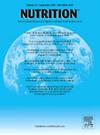Birth weight of a child and the occurrence of overweight and obesity in preschool and school age birth weight and overweight in children
IF 3.2
3区 医学
Q2 NUTRITION & DIETETICS
引用次数: 0
Abstract
Objective
Increasingly, studies say that both too low and excessive birth weight increase the risk of developing obesity. The study aimed to check whether there is a relationship between birth weight and the occurrence of overweight and parents' body weight in children aged 5, 10, and 15 y.
Methods
Out of 601 participants, 297 (51,2% ♀) were qualified for analysis, meeting the inclusion criteria for the study group. Participants were divided by their age at the time of the study into Group I (n=80 [51,2% ♀]) – aged 5 y old, Group II (n = 113 [51,6% ♀]) – 10 y, and Group III (n = 93 [50,5% ♀]) – 15 y. Birth data were obtained from the respondents as well as parental data - body mass and height, body mass index (BMI). Body mass was determined using a MC-780 body composition analyzer. Based on the information obtained, the occurrence of body weight abnormalities in children was determined according to percentile charts taking into account age and in the case of the parents' sex, the simplified World Health Organization (WHO) classification was used. The significance of the responses was estimated based on chi-square tests. Intergroup comparisons were made using the Kruskal-Wallis test.
Results
The relationship between data was determined using the Spearman's rank correlation test. The level of statistical significance was set at P < 0.05. The relationship between anthropometric data at the time of birth and at the time of examination in comparison to the parents was examined. Statistically significant correlations were found between birth weight and anthropometric values and BMI at the time of examination of children and their parents.
Conclusion
The child's birth weight correlates with the children's anthropometric values, but with age its importance decreases and the importance of the parents' weight increases.
儿童出生体重与学龄前和学龄儿童超重和肥胖的发生
越来越多的研究表明,过低和过高的出生体重都会增加患肥胖症的风险。本研究旨在探讨5岁、10岁和15岁儿童的出生体重与超重及父母体重的关系。方法在601名参与者中,有297名(51.2%♀)符合研究组的纳入标准。参与者在研究时按年龄分为I组(n=80[51.2%♀])- 5岁,II组(n= 113[51.6%♀])- 10岁,III组(n= 93[50.5%♀])- 15岁。出生数据来自受访者以及父母数据-体重和身高,体重指数(BMI)。使用MC-780身体成分分析仪测定体重。根据所获得的信息,根据考虑到年龄的百分位数图确定儿童体重异常的发生情况,在父母性别的情况下,使用世界卫生组织(世卫组织)的简化分类。根据卡方检验估计应答的显著性。使用Kruskal-Wallis检验进行组间比较。结果采用Spearman秩相关检验确定数据之间的关系。统计学显著性水平设为P <;0.05. 在出生时的人体测量数据之间的关系和在检查的时间比较父母进行了检查。在对儿童及其父母进行检查时,发现出生体重与人体测量值和BMI之间存在统计学上显著的相关性。结论儿童出生体重与儿童的人体测量值相关,但随着年龄的增长其重要性降低,父母体重的重要性增加。
本文章由计算机程序翻译,如有差异,请以英文原文为准。
求助全文
约1分钟内获得全文
求助全文
来源期刊

Nutrition
医学-营养学
CiteScore
7.80
自引率
2.30%
发文量
300
审稿时长
60 days
期刊介绍:
Nutrition has an open access mirror journal Nutrition: X, sharing the same aims and scope, editorial team, submission system and rigorous peer review.
Founded by Michael M. Meguid in the early 1980''s, Nutrition presents advances in nutrition research and science, informs its readers on new and advancing technologies and data in clinical nutrition practice, encourages the application of outcomes research and meta-analyses to problems in patient-related nutrition; and seeks to help clarify and set the research, policy and practice agenda for nutrition science to enhance human well-being in the years ahead.
 求助内容:
求助内容: 应助结果提醒方式:
应助结果提醒方式:


